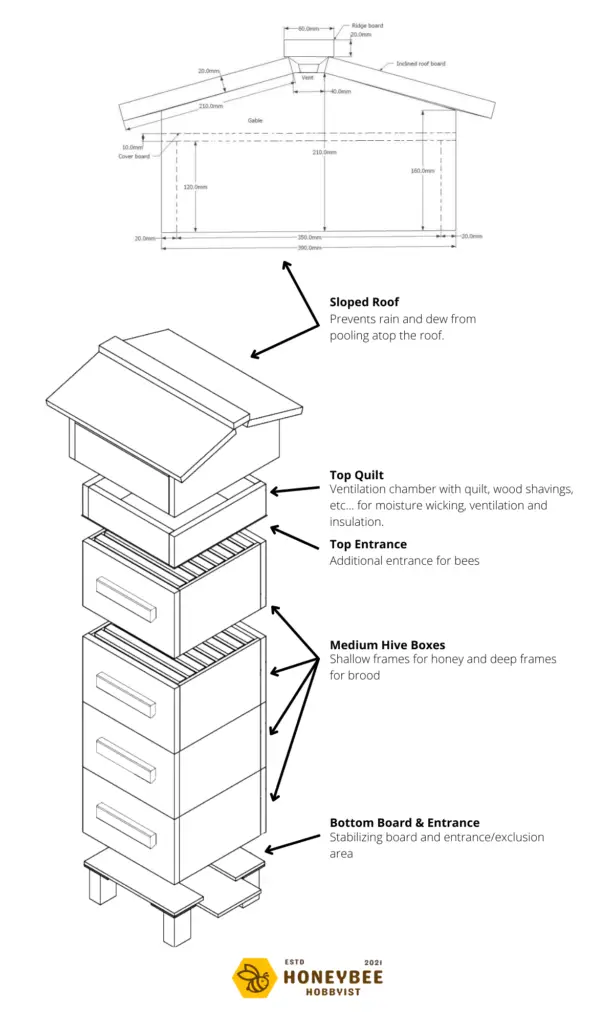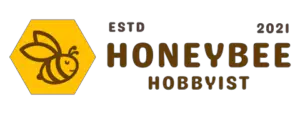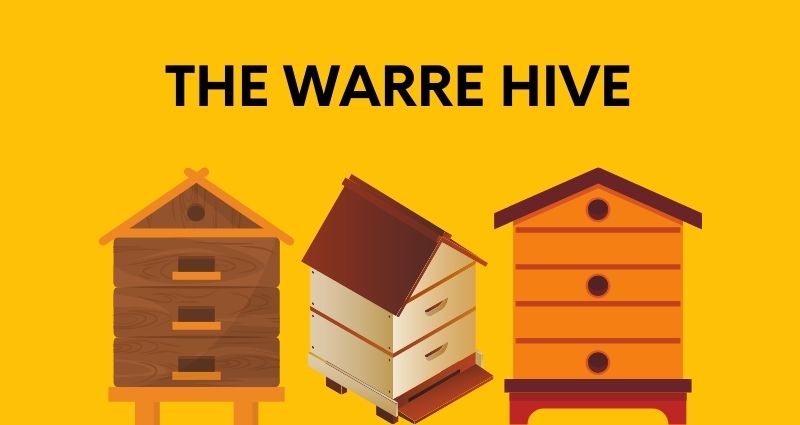The Warré hive mimics a hollow tree and allows bees to build their combs naturally. It requires minimal maintenance and only annual heavy lifting. While it does not produce as much honey as other types of hives, it guarantees pure, clean honey.
Warré Hive Design
Abbé Émile Warré (pronounced War-ray) designed this foundationless vertical top bar hive in the 1950s. After 50 years of research, he created a beehive that mimics a bee’s natural environment. It is an excellent option for advanced and beginner beekeepers. Let’s take a look at the hive design piece by piece.
- Sloped Roof – The top of the hive has a peaked roof, allowing water to run off it quickly. Some roofs are made from wood, and others are made from metal. You can easily replace the roof at any point during your beekeeping journey.
- Quilt Box – There is a small ventilation gap between the roof and the quilt box. This gap helps bees regulate the temperature of the hive. The quilt box is filled with wood shavings. The wood shavings wick moisture from the hive and provide winter insulation.
- Top Entrance – Sometimes, a top entrance is used to allow for additional ventilation and access for the bees.
- Cloth – This thin cloth between the quilt box and the first box is crucial. Without it, the bees would seal the quilt box to the first top box with propolis.
- First Warré Box – Each square box has eight vertical bars and a wedge comb guide that encourages the bees to build straight down. The top bars are spaced methodically, leaving just enough bee space that allows the bees to move freely between each comb. This top box is where the bees will lay brood and create honey first.
- Following Warré Boxes – As the bees work downwards, the lower boxes will be primarily empty comb, used for clustering.
- Bottom Board & Entrance – The bottom of the hive is usually a few inches off the ground. This is good for moisture control and ventilation. The bees appreciate the small exterior landing board, which makes entering the hive easier. The screened bottom board is a natural way to combat and control varroa mites.
Many manufacturers offer designs with windows. The windows allow you to peek in and see how the bees work and how the combs are coming along. This is a non-invasive, bee-friendly way to check on the hive.

Why Is It Called the People’s Hive?
Warré originally designed this hive to be used by people who lived on homesteads. Many of these families lived off of their land and made trades to obtain foods and products they didn’t have. To not take away from the other daily chores, this hive needed to be easy to care for.
His main objective was to create a happy environment for the honeybees and the beekeepers. Warré made The People’s Hive for the working class.
How Much Honey Does the Warré Hive Produce?
From one box, you can expect approximately 25 pounds of honey. Following the designer’s advice, you should harvest a full box of honey from the top in the fall and add an empty box to the bottom (aka nadiring) in the spring.
Warré boxes are generally only harvested once a year when the box is full of capped honey. If you harvest too early, you will likely pull out a honeycomb with brood still in it.
How to Extract Honey From the Warré Beehive
Unlike the Langstroth hive, the Warré hive is incompatible with an extractor. You will need just a few pieces of beekeeping equipment. You need a Warré hive tool, a white beekeeping suit, a few buckets, a strainer, and an optional smoker.
- First, take off the roof and the quilt box. Use a scraper to unstick the top box from the second box. If the bees have built the comb down, you’ll need to use a strong wire (guitar string) between the boxes first. Then, remove the cloth and move the box to a different location.
- Using the Warré tool, insert it between two combs, scrape it off the wall, strategically twist it and lift it to loosen each bar.
- Cut or scrape the honeycomb into a bucket. After ensuring there are no bees in the bucket, you can begin to crush, squeeze, and strain the honey from the honeycombs.
Remember, because there are no frames, you harvest entire boxes. When full, a honey box can weigh between 30 and 40 pounds. Some beekeepers like to use a bee escape board when separating the boxes. This helps to avoid losing bees and keeps them out of the honey.
After harvesting, you are left with a sticky box. If you leave the box far away from the colony, other bees will typically come by and clean it without any issues. If you prefer, you can also clean it yourself.
Warré Hive Assembly and Bee Installation
Some manufacturers give you the option of buying this hive fully assembled. If you choose to assemble it yourself, follow the instructions carefully. Typically, you will need wood glue, fasteners, a drill, a nail gun, a framing square, a tape measure, and more.
If you are an experienced carpenter, you might even want to try to build your own.
When the time comes, applying beeswax to the bars requires concentration and patience. Always heat the wax over a very low temperature and never leave it unattended.
Most beekeepers introduce the colony to the hive with two boxes. Sometimes a third is added to hold a feeder.
Configure the bottom box with bars and the upper box without bars. Put the queen cage on top of the bars and shake the worker bees to influence them to move up to the second box. Then you can place the bars in the upper box and put everything into place.
Warré Hive Maintenance
Luckily, the bees take care of almost all the hive management. The only thing the beekeeper needs to do is harvest the honey at the right time and add new boxes when necessary. If you notice that the bees are building a hive in the bottom box, that is a sign to go ahead and add another box.
When you open a hive, you disrupt the bees, change the temperature, change the humidity, and severely disrupt the pheromones that the bees use for communication. For this reason, Warré created a hands-off, low-maintenance hive that requires little human interference.
An excellent resource for anyone who owns a Warré hive is Émile Warré’s book, “Beekeeping for All,” or David Heaf’s manual, “Natural Beekeeping with the Warre Hive.”
Advantages
- The hive is low maintenance.
- It is an excellent option for new beekeepers.
- It mimics a natural beekeeping environment.
- Unlike traditional top bar hives, the Warré hive can be expanded.
- Because the bees need to make a new comb after each extraction, the honey you extract will be purer.
- The natural comb you extract can be used for other projects.
- The (typically) 12 by 12 boxes are lightweight and smaller than Langstroth boxes.
Disadvantages
- You can not/should not harvest individual combs.
- The combs are very fragile.
- It produces approximately half the amount of honey as a Langstroth hive.
- You need to lift the entire hive to add boxes to the bottom.
- Because it is not a standard design, fewer resources and mentors are available.
- Storage space for extra empty boxes is required.
Many other beehive types include the Langstroth, Top Bar, and modern Flow Hive. Or click here to review a full list.

